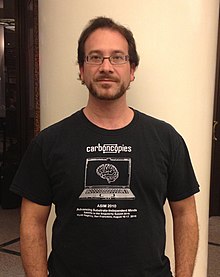Randal A. Koene | |
|---|---|
 Randal Koene in October 2014 | |
| Alma mater | McGill University, Delft University of Technology |
| Known for | Whole brain emulation, Mind uploading |
| Scientific career | |
| Fields | Neuroscience, Neuroengineering |
| Institutions | Tecnalia |

Randal A. Koene[1], a Dutch neuroscientist and neuroengineer, is recognized for his involvement as a co-founder of carboncopies.org,[2] an organization dedicated to advancing Substrate-Independent Minds (SIM). rom 2008 to 2010, Koene served as the Director of the Department of Neuroengineering at the Fatronik-Tecnalia Institute in Spain,[3] a research institution ranking among the third largest private research organizations in Europe. Koene holds a Ph.D. in Computational Neuroscience from McGill University's Department of Psychology, as well as an M.Sc. in Electrical Engineering with a specialization in Information Theory from Delft University of Technology. His academic pursuits include a tenure as a professor at Boston University's Center for Memory and Brain, and he co-founded the Neural Engineering Corporation of Massachusetts. Koene also established MindUploading.org.[4] He first proposed the term and specific approach called whole brain emulation, the purpose of which is the technological accomplishment of mind transfer to a different substrate. In his professional research, Koene focuses on the implementation of whole brain emulation, which involves creating large-scale, high-resolution representations and emulations of neuronal circuitry activity, essential for the development of patient-specific neuroprostheses. His contributions extend to his membership in the Oxford working group convened in 2007, aimed at formulating the initial roadmap toward whole brain emulation.[5]
Koene has professional expertise in computational neuroscience, psychology, information theory, electrical engineering and physics. He organizes neural engineering efforts to obtain and replicate function and structure information that resides in the neural substrate for use in neuroprostheses and neural interfaces. Based on NETMORPH,[6] Koene's computational framework for the simulated morphological development of neuronal circuitry, his lab is creating a Virtual Brain Laboratory to give neuroscientists, neuroengineers and clinicians large-scale high-resolution quantitative tools analogous to the computational tools that have become essential in fields such as genetics, chemistry or the aero-space industry. This effort bridges scales and will help determine how significant functions are encoded robustly in neural ensembles, and how those functions can nevertheless depend in specific ways on the detailed biophysics of particular component physiology.